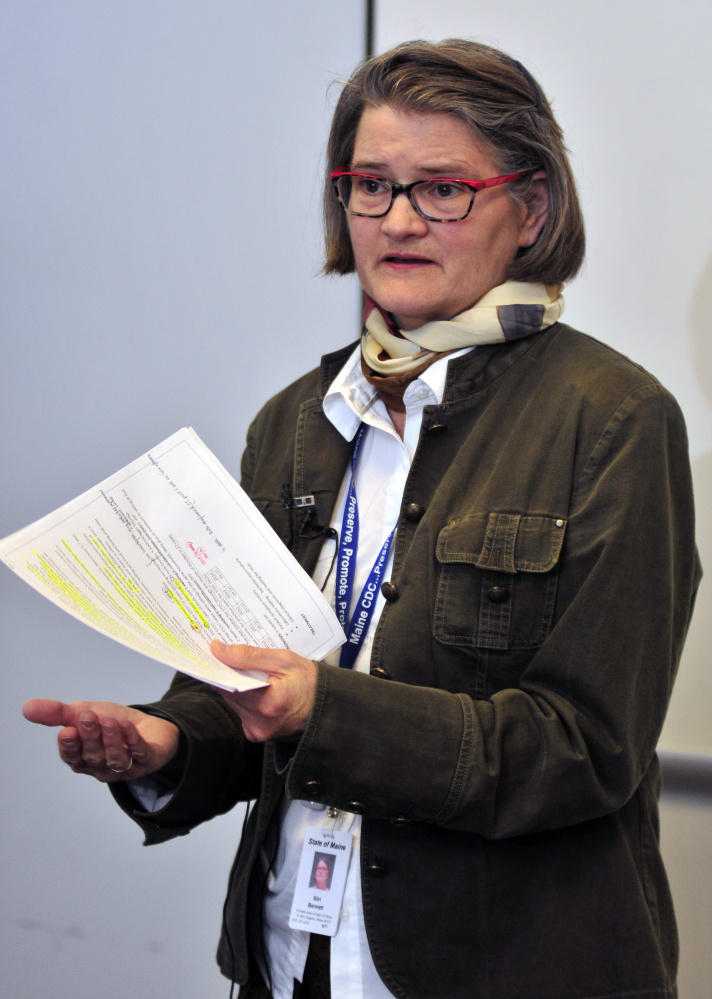AUGUSTA — State health officials said Friday they have positively identified a common strain of E. coli that led to the illness of one toddler and the death of another after both children visited the same petting zoo at the Oxford County Fair.
“Late this morning Maine’s health and environmental testing laboratory identified the strain of E. coli in these two cases,” Dr. Siiri Bennett, the state epidemiologist for the Maine Center for Disease Control and Prevention, said during a news conference Friday afternoon. “The strain, known as O111, is one of many strains that can be responsible for an illness” such as hemolytic uremic syndrome, or HUS.
“The strain and molecular typing from each patient was identical, making it highly likely that the cases acquired the illness from the same source,” Bennett said. “We cannot say with certainty what that common exposure may have been. We are continuing our investigation, which becomes more extensive when a molecular match like this exists between two cases. Since we know that the Oxford County fairground is a place where both children visited, environmental samples were collected and are being tested.”
One of the toddlers, 20-month-old Colton James-Brian Guay, died this week. The other, Myles Herschaft, remained in fair condition Friday afternoon at Maine Medical Center in Portland. Myles, 17 months, of Auburn, also suffered from hemolytic uremic syndrome.
Cases of E. coli contamination must be reported to the Maine CDC. Bennett said 26 cases of E. coli contamination have been reported this year. Of those, six developed HUS, but the two involving the youngsters are the only cases of type O111.
Guay’s death is the “first death we are aware of” resulting from the illness, Bennett said.
The state is still investigating the source of the E. coli infection, although the families of the toddlers have publicly said that they both visited the petting zoo at the Oxford County Fair in late September.
John Martins, spokesman for the Department of Health and Human Services, said Friday it’s not clear whether livestock at the fair are the source of the bacteria because the testing remains incomplete. The bacteria could have also come from other sources such as food, but it’s not always possible to identify the source, Martins and Bennett said.
Bennett also said E. coli of this nature has been found on contaminated lettuce, uncooked beef, unpasteurized milk products and a whole range of foods identified as the source for outbreaks in the past.
Asked about the sources of contamination for reported cases in 2014 and 2015, Bennett didn’t cite specific sources and instead said that state epidemiologists try to investigate a possible source of infection, “but sometimes that’s not possible because a person may have had multiple common exposures.” Of the four other cases of HUS reported this year, all involved children under the age of 5 and the source of infection in each case was undetermined.
Even so, cows are a known “reservoir” for the bacteria, she said.
Bennett said state health officials collected and are testing environmental samples from the main barn, outside animal pens and the livestock area for the petting zoo at the fairgrounds. She said the test would not be completed until next week, which is when the agency expects to offer an update on the search for the source of the bacteria that sickened the youngsters.
The incubation period for the illness is up to 10 days, so anyone who might have become ill from exposure would be sick by now, Bennett said. State health officials have not received any further reports of illness.
Bennett pointed to good hand-washing with soap and hot water as a “first line of defense” against contracting bacteria, saying hand-sanitizer would be recommended if access to soap and water is unavailable. Hand sanitizer, such as those offered at fairs, is an acceptable supplement, she said, but soap and water is better.
“People need to be aware there is potential for contracting illness from animals, as well as from other sources, and it always pays to be vigilant to wash your hands,” she said.
She also said anyone experiencing severe diarrhea or bloody diarrhea should contact their healthcare provider.
Children under the age of 5 and elderly people are more susceptible to such illnesses, Bennett said, and infants under the age of 5 are more likely to suffer complications.
Martins said the state CDC is working with the state Department of Agriculture on more educational campaigns about hand-washing to prevent disease.
“Clearly this is a tragic situation,” Martins said. “We’ve been in conversations with them about what other campaigns can we do around hand-washing.”
Betty Adams — 621-5631
Twitter: @betadams
Copy the Story LinkSend questions/comments to the editors.







Success. Please wait for the page to reload. If the page does not reload within 5 seconds, please refresh the page.
Enter your email and password to access comments.
Hi, to comment on stories you must . This profile is in addition to your subscription and website login.
Already have a commenting profile? .
Invalid username/password.
Please check your email to confirm and complete your registration.
Only subscribers are eligible to post comments. Please subscribe or login first for digital access. Here’s why.
Use the form below to reset your password. When you've submitted your account email, we will send an email with a reset code.